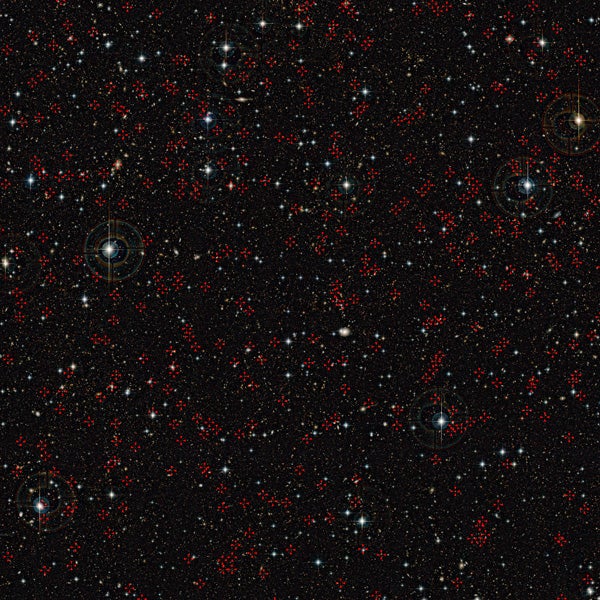ESO’s VISTA telescope has been trained on the same patch of sky repeatedly to slowly accumulate the dim light of the most distant galaxies. In total, more than 6,000 separate exposures with a total effective exposure time of 55 hours, taken through five different colored filters, have been combined to create this picture. This image from the UltraVISTA survey is the deepest infrared view of the sky of its size ever taken.
The VISTA telescope at ESO’s Paranal Observatory in Chile is the world’s largest survey telescope and the most powerful infrared survey telescope in existence. Since it started work in 2009, most of its observing time has been devoted to public surveys, some covering large parts of the southern skies and some more focused on small areas. The UltraVISTA survey has been devoted to the COSMOS field, an apparently almost empty patch of sky that has already been extensively studied using other telescopes, including the NASA/ESA Hubble Space Telescope. UltraVISTA is the deepest of the six VISTA surveys by far and reveals the faintest objects.
Data from the VISTA surveys, totaling more than 6 terabytes of images, are now being processed in data centers in the United Kingdom, and in the case of UltraVISTA in France, and are flowing back into the ESO science archive and being made available to astronomers around the world.
At first glance, the UltraVISTA image looks unremarkable — a few bright stars and a sprinkling of fainter ones. But, in fact, almost all of those fainter objects are not stars in the Milky Way, but remote galaxies, each containing billions of stars. Enlarging the image to fill the screen and zooming in reveals more and more of them, and the image records more than 200,000 galaxies in total.
The expansion of the universe shifts light from distant objects toward longer wavelengths. For starlight coming from the most distant galaxies that we can observe, this means that most of the light falls in the infrared part of the spectrum when it gets to Earth. As a highly sensitive infrared telescope with a wide field of view, VISTA is uniquely powerful for spotting distant galaxies in the early universe. By studying galaxies in redshifted light at successively larger distances, astronomers also can trace how galaxies were built up and evolved over the history of the cosmos.
Close inspection of the picture reveals tens of thousands of previously unknown reddish objects scattered between the more numerous cream-colored galaxies. These are mostly remote galaxies seen when the universe was only a small fraction of its present age. Early studies of the UltraVISTA images, in combination with images from other telescopes, have revealed the presence of many galaxies that are seen when the universe was less than a billion years old and a few are seen at even earlier times.
Although the current UltraVISTA image is already the deepest infrared image of its size in existence, observations are continuing. The final result, a few years from now, will be significantly deeper still.
Surveys are vital resources for astronomers, and ESO has put in place a program so that the rich heritage from both VISTA and its visible-light companion, the VLT Survey Telescope will be accessible to astronomers for decades to come.










